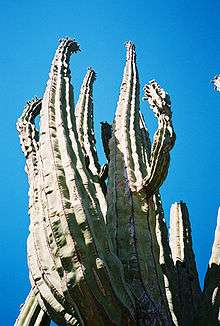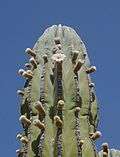Pachycereus pringlei
Pachycereus pringlei, also known as Mexican giant cardon or elephant cactus, is a species of cactus native to northwestern Mexico in the states of Baja California, Baja California Sur, and Sonora. It is commonly known as cardón, a name derived from the Spanish word cardo, meaning "thistle".[2]
| Pachycereus pringlei | |
|---|---|
 | |
| Pachycereus pringlei in Baja California, Mexico | |
| Scientific classification | |
| Kingdom: | |
| (unranked): | |
| (unranked): | |
| (unranked): | Core eudicots |
| Order: | |
| Family: | |
| Genus: | |
| Species: | P. pringlei (ቆልቋል kolkal) |
| Binomial name | |
| Pachycereus pringlei | |
| Synonyms | |
|
Cereus pringlei S.Watson[1] | |
Large stands of this cactus still exist, but many have been destroyed as land has been cleared for cultivation in Sonora.
The fruit of this cactus was an important food for the Seri people in Sonora, who call the cactus xaasj.[3]
The flesh of this cactus contains alkaloids, and may have been used as a psychoactive plant in Mexico.[4]
A symbiotic relationship with bacterial and fungal colonies on its roots allows P. pringlei to grow on bare rock even where no soil is available at all, as the bacteria can fix nitrogen from the air and break down the rock to produce nutrients. The cactus even packages symbiotic bacteria in with its seeds.[5][6][7]
Morphology
A cardon specimen is the tallest living cactus in the world, with a maximum recorded height of 19.2 m (63 ft),[8][9] with a stout trunk up to 1 m (3.3 ft) in diameter bearing several erect branches. In overall appearance, it resembles the related saguaro (Carnegiea gigantea), but differs in being more heavily branched and having branching nearer the base of the stem, fewer ribs on the stems, blossoms located lower along the stem, differences in areoles and spination, and spinier fruit.
Its flowers are white, large, nocturnal, and appear along the ribs as opposed to only apices of the stems.
Lifespan and growth
An average mature cardon may reach a height of 10 metres (30 ft), but individuals as tall as 18 metres (60 ft) are known.[10] It is a slow-growing plant [11] with a lifespan measured in hundreds of years, but growth can be significantly enhanced in its initial stages by inoculation with plant growth-promoting bacteria such as Azospirillum species.[12][13][14] Most adult cardon have several side branches that may be as massive as the trunk. The resulting tree may attain a weight of 25 tons.[15]
Gallery
- Field of P. pringlei
- Habit
- With an osprey nest atop
 Flowering
Flowering.jpg) Husk of a fallen fruit
Husk of a fallen fruit
Notes
References
- "Pachycereus pringlei". Germplasm Resources Information Network (GRIN). Agricultural Research Service (ARS), United States Department of Agriculture (USDA). Retrieved 2011-11-03.
- Chamlee, Bob. "Cardón cactus, Pachycereus pringlei". Los Cabos Guide to Good Eating and More!. Archived from the original on 2006-04-15. Retrieved 2011-11-03.
-
- Felger, Richard; Mary B. Moser. (1985). People of the desert and sea: ethnobotany of the Seri Indians. Tucson: University of Arizona Press. ISBN 0-8165-0818-6.
- Brown, Ethan (September 2002). "Professor X". Wired Magazine.
- Puente, M. E.; Y. Bashan; C. Y. Li; V. K. Lebsky (September 2004). "Microbial populations and activities in the rhizoplane of rock-weathering desert plants. I. Root colonization and weathering of igneous rocks". Plant Biology. Stuttgart. 6 (5): 629–42. doi:10.1055/s-2004-821100. PMID 15375735.
- Puente, M. E.; C. Y. Li; Y. Bashan (September 2004). "Microbial populations and activities in the rhizoplane of rock-weathering desert plants. II. Growth promotion of cactus seedlings". Plant Biology. Stuttgart. 6 (5): 643–50. doi:10.1055/s-2004-821101. PMID 15375736.
- Walker, Matt (2009-08-19). "How cacti become 'rock busters'". BBC News.
- Salak, M. "In search of the tallest cactus". Cactus and Succulent Journal. 72 (3).
- "Windstorm Fells 78-Foot Cactus--Tallest in World". Retrieved 2015-08-04.
- (León de la Luz and Valiente 1994).
- (Roberts, 1989)
- (Bashan et al., 1999
- Carrillo et al., 2000
- Puente and Bashan, 1993
- (Gibson and Nobel, 1986).
External links
![]()
![]()